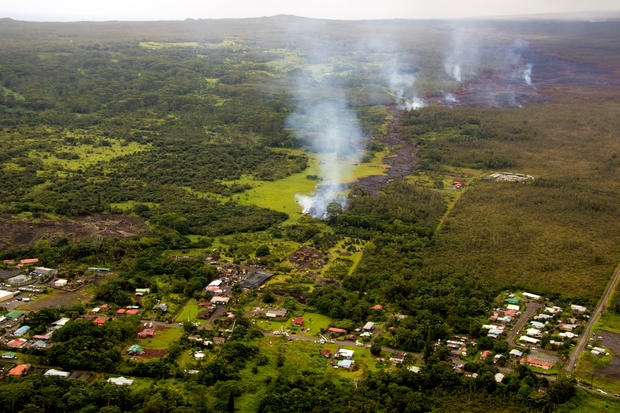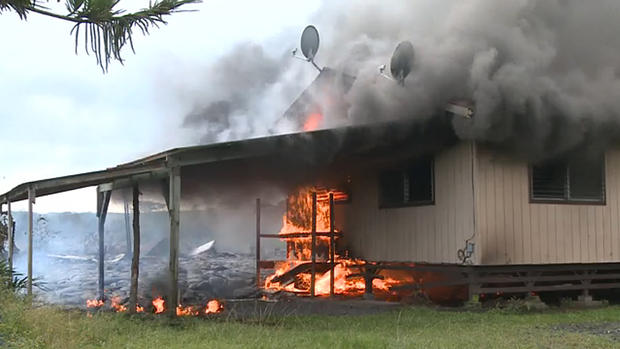"Despair": Hawaii lava enters residential property
HONOLULU -- After slowly snaking through unoccupied land for weeks, a river of asphalt-black lava has entered a residential property on Hawaii's Big Island.
The lava was within yards of a home in the rural community of Pahoa Village on Tuesday.
Meanwhile, officials say an elementary school in the molten stream's projected path will be closed starting Wednesday.
Depending on which side of the flow students live on, they'll either go to a newly built temporary facility or other area schools starting Nov. 7 and 10.
Residents of the small town have had weeks to prepare for what's been described as a slow-motion disaster. Most have either already left or are prepared to go when necessary.
County officials are making arrangements for those living in the lava's path to be able to watch the lava destroy their homes as a means of closure.
"You can only imagine the frustration as well as ... despair they're going through," Hawaii County Civil Defense Director Darryl Oliveira said.
CBS affiliate KGMB reports that neighbors reported that the first structure had been claimed by the lava flow. However, it was a shack and not a home.
USGS geologists with the Hawaiian Volcano Observatory say the leading edge of the lava flow is about 40 to 50 yards wide, the station reported.
County officials have warned those with respiratory problems to stay indoors because of the smoke.
Over the weekend, the lava crossed a road in Pahoa Village, considered a main town in the island's rural Puna district. It was getting dangerously close to Pahoa Village Road, which goes straight through downtown.
THE LATEST
The flow's advancement has been inconsistent, ranging from about 2 to 20 yards per hour, depending on topography, said Janet Babb, a spokeswoman for the Hawaiian Volcano Observatory.
On Monday, it was moving 5 to 10 yards an hour.
The couple living in the house closest to the flow left, but they have returned periodically to gather belongings Oliveira said. At one point they allowed civil defense workers to view the lava from their balcony.
Imelda Raras lives on Apaa Street, which was hit by the lava Sunday. She said she and her husband are ready to go to a friend's home if officials tell them they should leave.
"We are still praying," Raras said. "I hope our home will be spared."
SLOW CREEP
Scientists began warning the public about the lava Aug. 22. At the time, residents were cleaning up from a tropical storm that made landfall over the Puna district.
The lava has advanced and slowed as residents waited and watched.
Kilauea volcano, one of the world's most active, has been erupting continuously since 1983.
Decomposition of vegetation in the lava's path has created methane gas, which if it accumulates and is ignited by heat can cause a blast, Babb said.
"It's not a massive explosion," she said. "But it can dislodge rocks. It can hurl large rocks several feet."
WHO IS AT RISK?
Initially, the lava seemed headed for the Kaohe Homesteads, a sparsely populated subdivision.
But the lava reached vacant lots and then stalled. It skirted a corner of the subdivision and then headed toward Pahoa.
Pahoa has small-town charm, but it's the "only town in a commercial sense in lower Puna," said state Sen. Russell Ruderman, who represents the district and runs a natural food store in Pahoa.
Because the lava could change direction, any community in Puna is at risk.
PREPARATIONS
Sporadic suspensions in the lava's movement have given emergency crews time to build alternate routes to town.
Crews near the lava's leading edge have been wrapping power poles with concrete rings as a layer of protection from the heat.
Raras said they began putting their belongings in storage in September. What they aren't able to take with them, they're photographing for insurance purposes.
HOW LONG WILL THE RISK REMAIN?
No one knows if the lava flow will stop, change direction or hit more homes.
In the 1990s, about 200 homes were destroyed by lava flows from Kilauea.

